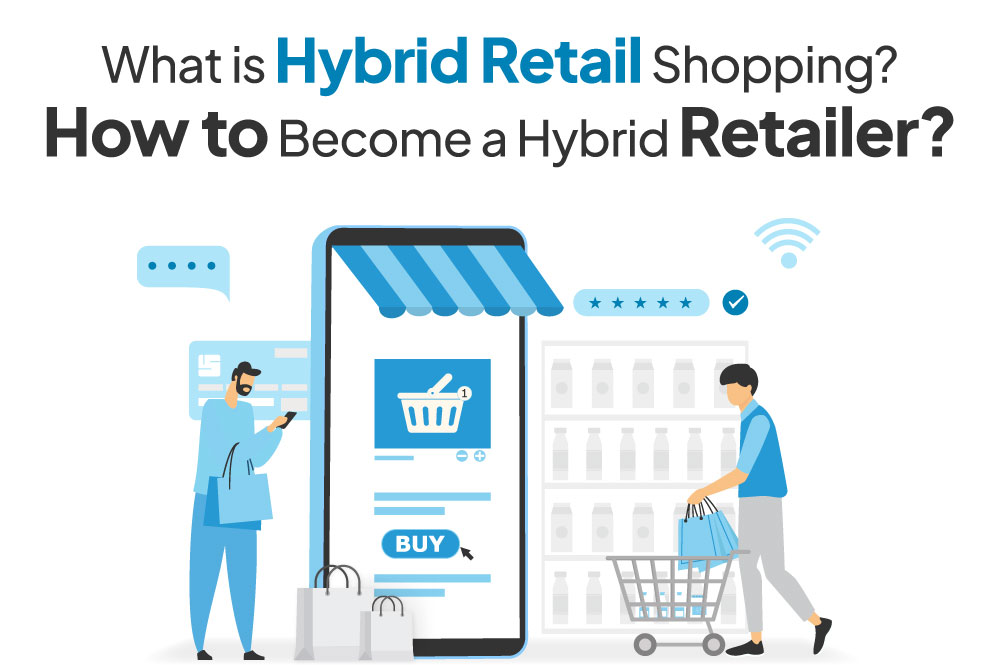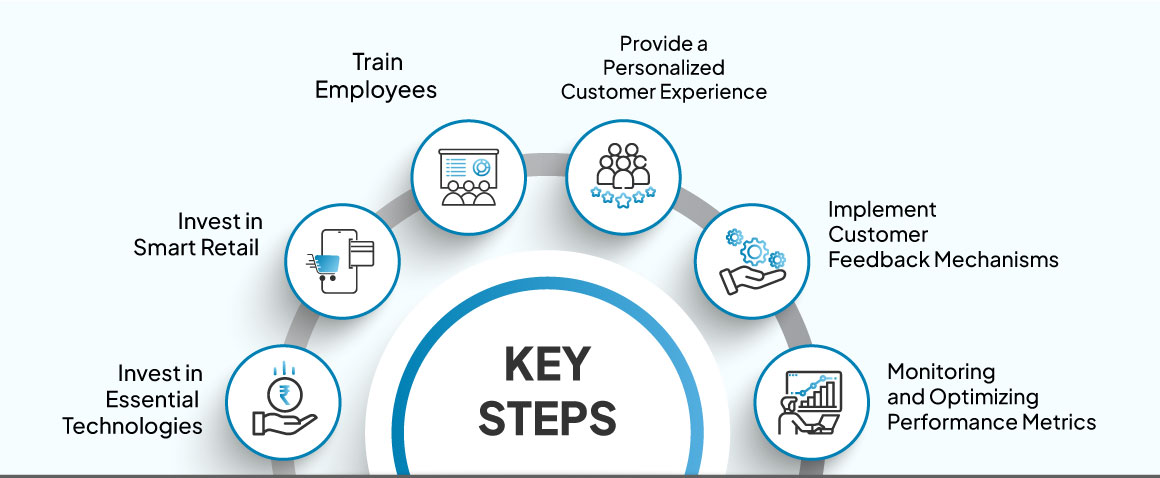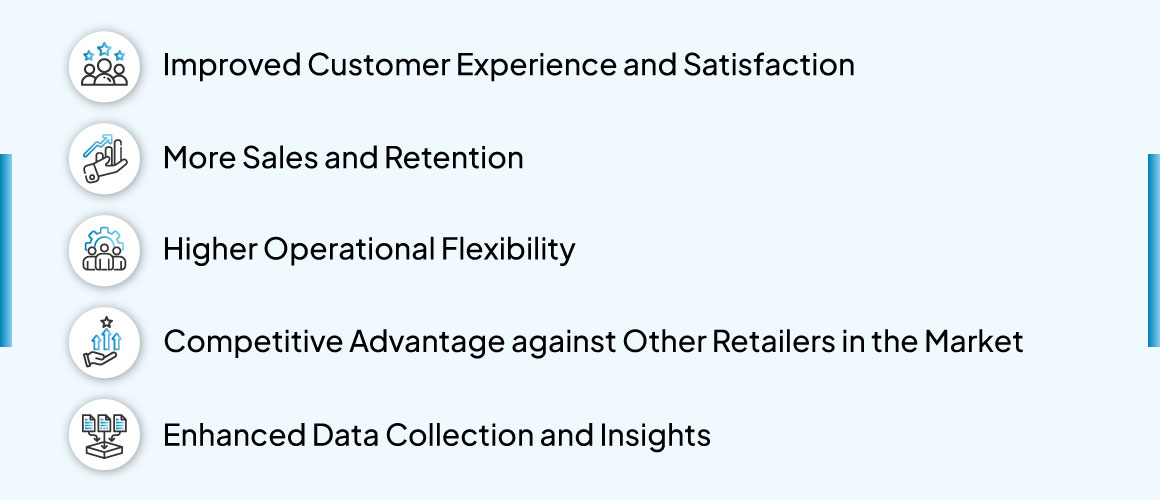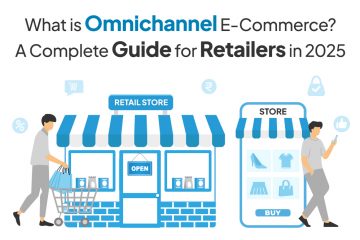What is Hybrid Retail Shopping? How to Become a Hybrid Retailer?
November 8, 2024

If you, as a retailer, sell products at a local store while also having an online store where your customers can flip through an online catalog, then you already are a hybrid retailer. The world of hybrid retail has it both ways—convenient online shopping combined with the fulfilling shopping experience of a brick-and-mortar store.
Despite the lucrative benefits hybrid retail offers (earnings from both physical and online stores) the decision to sell online along with physical stores is labor-intensive. Managing inventory, billing, CRM, purchases, sales, and accounts for both stores is overwhelming for naive retailers. This is where they need an integrated business management software that can handle all processes for both stores and assist retailers in going hybrid.
Let’s walk you through hybrid retail, its importance in the evolving retail market of today, and strategies to implement a hybrid retail model to refine the overall shopping experience for your customers.
Hybrid retail is a business model integrating conventional brick-and-mortar retail with online e-commerce. Hybrid retailers offer customers enhanced shopping exposure. More than half of consumers, nearly 56%, like to shop online and in-store equally. The concept of hybrid retail perfectly fits in this digital age where e-commerce is on the surge and consumer expectations are constantly changing.
It’s no piece of cake to keep your customers engaged and drawn into your business. That’s quite challenging! But what if you could offer them the ultimate shopping experience, combining the ease of online shopping with the personal touch of an in-store visit? That’s where hybrid retail becomes a must.
Sounds interesting, doesn’t it?
Your customer can shop as they want—from the comfort of their couch or by visiting your store. With this level of flexibility and convenience, you are not only meeting their need; but making their shopping experience personalized and truly memorable. It increases your chances of sales, beats both types of competition (retail/online), and increases your customer size.
| Hybrid Retail Context and Definition | Context and Definition |
| From Retailer’s Perspective | Unified omnichannel strategy merging brick-and-mortar and digital platforms to optimize operations for both types of sales |
| Shopper’s Perspective | Getting seamless online and in-store shopping experience, combining e-commerce convenience with physical store benefits. |
| Technology Provider’s Perspective | Developing integrated solutions with combined modules for inventory, accounting, POS, billing, and CRM. Solutions can take care of both retail and e-store operations. |
With the emergence of innovation and the human race entering into the depths of the digital sphere every minute, hybrid retail has surfaced as the gleaming light for the retail world. Let’s dig in a little deeper. Over the last decade, the retail industry has dramatically changed. From traditional brick-and-mortar shops to fully-fledged e-commerce, consumers’ ways of shopping have substantially evolved.
The rise of hybrid retail presents a new realm bringing together both worlds—online shopping and in-store purchases—into a unified and cohesive shopping experience. Connected stores and blended shopping are among 2024’s key retail trends, report.
| Integration of Shopping Experience | Merges online shopping with in-store shopping for customer convenience. |
| Common Practices of Hybrid Retail | View and check products online and compare prices. Order online and pick up in-store to save shipping costs. |
| Benefits for Consumers | It provides convenience and flexibility in shopping modes |
| Benefits for Retailers | Enhances customer interaction and loyalty toward brands. Boosts efficiency in the management of retail businesses. |
| Technology’s Role in Hybrid Retail | Advanced technologies, such as data analytics, give precious insights into customer behavior. Helps create immersive shopping experiences and maximizes sales for retailers. |
Hybrid retail models are increasingly becoming noteworthy to any retail business wanting to adapt to the growing demands of the consumer base in the current marketplace trends. There are two prominent models for hybrid retailers: Omnichannel and Phygital.
Each of the models differs as they merge various retail approaches but are similar in their approach to creating a uniform, interactive shopping experience.
Are you really meeting your customers where they are, or are you just hoping they’ll find you? Picture this: A shopper starts on your website, compares product options on their mobile device, and eventually buys in your brick-and-mortar store, all without a hitch. That’s the beauty of omnichannel ecommerce for hybrid retail environments!
Omnichannel Retail essentially connects the dots between different shopping channels—online, in-store, mobile, and others, into a cohesive, smooth customer experience.
It ensures that your customers are consistently exposed to your brand across all platforms for extended engagement. It is not a strategy; it is the future of shopping—where you are always in touch with your customers every moment.
Check out the omnichannel integration features that can be seamlessly integrated into POS software to elevate hybrid retail to the next level:
Phygital; the term sounds innovative, right? So is the concept of phygital retail! It concentrates on an interactive shopping experience blending the physical and digital to ensure an unparalleled customer experience. Phygital retail is beyond a passing trend, it represents the future of shopping. It combines touch-based (sensory experiences of a physical store) with the convenience of online shopping.
For instance, an immersive in-store digital kiosk may enable your customers to pick products unavailable on store shelves, letting them review and compare these products, and check product availability. Who wouldn’t want to experience this truly engaging shopping adventure? We bet all your customers would. Imagine turning your store into a phygital hotspot where digital and physical shopping fuse together—all this is possible with the right POS software—it boosts customer satisfaction, engagement, and eventually your sales. Here’s how you can benefit from your phygital features:
While both omnichannel and phygital retail are worthwhile components of hybrid retail, each of them has its strengths to drive sales and retail success.
Like any other transition in business, shifting to hybrid retail is not always easy. The transformation to a hybrid retail model barely comes without any hitches. For a brick-and-mortar retailer who wants to go hybrid, there are challenges related to:
What’s the solution? Omnichannel integrated POS solutions—would be all you need! To rise above and beyond the mentioned challenges, retailers can take assistance from omnichannel integrated seamless POS platforms. These tools strongly help in aligning your older systems with tech-driven systems smoothly, further easing the setup and processes across all connected channels for sound hybrid retail.
Devising an effective hybrid retail strategy involves several steps that can strongly influence customer satisfaction and in turn your retail business performance. Seamlessly implement an engaging and harmonious shopping experience across all digital and physical touchpoints. Invest in omnichannel and phygital retail models to synchronize all platforms and inventories.
Make constant channel switching smooth and flawless for your consumers. All these go a long way in keeping the brand message and experience intact at every touchpoint, whether a customer is browsing online or physically present in the store.
Have a look at the key steps below:

The first tool that you need to go hybrid is omnichannel ecommerce software. However, also invest in quality omnichannel software like VasyERP that has all the modules and features that one needs for hybrid retail management.
Innovative technologies like smart data capture, smart retail functions, and modern systems of payments can ensure way easier interactions with your customers. These tools offer a breeze while shopping and can foster improved customer engagement.
Empower your employees with the training required to excel in hybrid retail. Inform them about new technologies and how they can communicate with customers through every channel. Ongoing training sessions, workshops, and seminars have been found quite useful in keeping your team updated with the latest trends. An adaptable workforce can easily adjust to new strategies and contribute to fruitful retail business.
Make use of customer data to introduce a personal touch in-store. Through the analysis of customer behavioral tendencies, you get a chance to personally recommend and target marketing campaigns for your audience. Often, personalization extends to email marketing strategies, whereby you can make lucrative offers to customers that best suit their interests. With such a level of personalization—your customers would valued, more prone to making repeated purchases.
Establish a mechanism for regular customer feedback and analyze it to continuously improve your services. You can use surveys, online reviews, or even reach out to customers directly for interviews. Besides, the culture of open communication will let customers know that their opinions matter to you. That’s how your brand keeps up with innovation and answers the needs of the current market!
Key Performance Indicators (KPIs) to monitor include customer satisfaction, the conversion rate of sales, and customer engagement. Regularly monitoring these trends will allow you to fine-tune your strategy for better and more promising returns. You can also view historical performance trends through various analytics tools. Setting specific aims and aligning

Multi-channel shopping avenues provided by hybrid retail offer a very strong enhancement of customer experience. Switching between online and offline is a freedom, which consumers appreciate, thus making them more satisfied.
Research has proved that hybrid shoppers spend more. Indeed, other studies confirm that such cross-channel consumers could lead to a higher sales conversion rate and improved loyalty. This is because the cross-channel consumer also expects superior service.
It enables them to make the business operations dynamic, changing with every passing day due to the flux in consumer demand. This is the competitive advantage for any retailer in a constantly changing retail environment.
A well-implemented hybrid retail model helps a brand carve its niche in the market amongst other competitors. A memorable shopping experience leaves a print in customers’ minds, thus encouraging customer loyalty and repeat business.
Hybrid retailing helps gather data from both online and offline channels, providing a more comprehensive view of customer behavior and preferences. Adopting a hybrid retail model helps businesses become more resilient to market changes and unforeseen circumstances with strong analytics as their savior.
Hybrid retail is a robust model that will reshape the shopping future. Integrating online and offline components, helps your brand meet evolving consumer expectations, benefit from increased sales, and retain customers for the long term.
So, what are you waiting for? Get started with your hybrid retail strategy today and witness your business grow with outstanding solutions like VasyERP. Here, we walk you through the exciting world of hybrid retail, not just equipping you with the necessary tech models but also with the skill to take your brand to exponential heights.
Connect with us for business solutions that will make you stand out in the hybrid landscape!

Are you also wondering what omnichannel e-commerce is? ...
September 29, 2025

Have you ever wondered how to simplify the complexity o...
July 17, 2023
